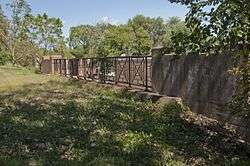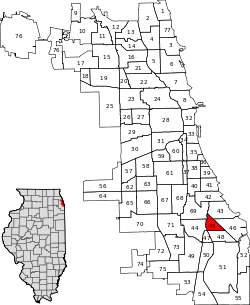Avalon Park, Chicago
Avalon Park, located on the south side of the U.S. city of Chicago, Illinois, is one of the city's 77 semi-official community areas and is named after its main park. Its boundaries are 76th St. to the north, South Chicago Ave. to the east and 87th St. to the south. The community area includes the neighborhoods of Avalon Park, Marynook and Stony Island Park.
Avalon Park | |
|---|---|
Community area | |
| Community Area 45 - Avalon Park | |
 The abandoned bridge of the Nickel Plate Railroad over 83rd Street | |
 Location within the city of Chicago | |
| Coordinates: 41°45′N 87°35.4′W | |
| Country | United States |
| State | Illinois |
| County | Cook |
| City | Chicago |
| Neighborhoods | list
|
| Area | |
| • Total | 1.25 sq mi (3.24 km2) |
| Population (2015[1]) | |
| • Total | 9,780 |
| • Density | 7,800/sq mi (3,000/km2) |
| Demographics 2015[1] | |
| • White | 0.5% |
| • Black | 97.4% |
| • Hispanic | 0.6% |
| • Asian | 0.6% |
| • Other | 0.9% |
| Time zone | UTC-6 (CST) |
| • Summer (DST) | UTC-5 (CDT) |
| ZIP Codes | parts of 60617, 60619 |
| Median household income | $41,531[1] |
| Source: U.S. Census, Record Information Services | |
History
Early settlers included German and Irish railroad workers in the 1880s who built homes on stilts to raise them above the often flooded marshlands. Some maps show a Hog Lake occupying the area of the present day park. Johnathon Pierce began to develop the area under the name "Pierce's Park" in 1888. The Avalon Park Community Church (founded in 1896) led an effort to change the name of the area, and in 1910 the name was changed to Avalon Park. A sewer system created in 1910 helped to drain the area and facilitate further development.[2]
Avalon Park experienced a major demographic change in the 1960s. In the 1960 census, Avalon Park was 0% African American (only six of 12,710 residents). A decade later, Avalon Park was 83% African American, according to the 1970 census. The African American population continued to increase, making up 98% of the residents by 1990. The change in the neighborhood was different from the "white flight" that many other Chicago neighborhoods experienced: the average educational level increased, while the poverty rate decreased from 6.1% to 5.1% between 1960 and 1970. Unlike in some other rapidly changing neighborhoods, the homeownership rate remained high – still above 70%, as it has been since 1950. In the 1980 census, 59% of the population were employed in white-collar occupations; this rose to 65% in the 2000 census.
(Source: "There Goes the Neighborhood: Racial, ethnic, and class tensions in four Chicago neighborhoods and their meaning for America" by William Julius Wilson and Richard P. Taub; 2006. The book gives Avalon Park a pseudonym of "Groveland".)
Demographics
| Historical population | |||
|---|---|---|---|
| Census | Pop. | %± | |
| 1930 | 10,023 | — | |
| 1940 | 10,464 | 4.4% | |
| 1950 | 11,358 | 8.5% | |
| 1960 | 12,710 | 11.9% | |
| 1970 | 14,412 | 13.4% | |
| 1980 | 13,792 | −4.3% | |
| 1990 | 11,711 | −15.1% | |
| 2000 | 11,147 | −4.8% | |
| 2010 | 10,185 | −8.6% | |
| Est. 2015 | 9,780 | −4.0% | |
| [1][3] | |||
According to data collected by the Chicago Metropolitan Agency for Planning, there were 9,985 people and 3,880 households in Avalon Park. The racial makeup of the area was 0.6% White, 97.2% African American, 0.4% Asian, 1.2% from other races. Hispanic or Latino of any race were 0.7% of the population. In the area, the population was spread out, with 23.3% under the age of 19, 17.6% from 20 to 34, 15.7% from 35 to 49, 23.1% from 50 to 64, and 20.3% who were 65 years of age or older. The median age was 44 years compared to a citywide median age of 34 years.[4]
Health and healthcare
According to the Pritzker School of Medicine, 12% of residents are uninsured, though 92% report having a consistent primary care provider. The current life-expectancy in Avalon Park is 75 years which compares to a citywide average of 77 years. The infant mortality rate is three times higher than the citywide average. The obesity rate is 56% and 15% of residents are diabetic.[5]
Politics
Avalon Park is a stronghold for the Democratic Party in presidential elections. In the 2016 presidential election, Avalon Park cast 5,510 votes for Hillary Clinton and cast 87 votes Donald Trump.[6] In the 2012 presidential election, Avalon Park cast 6,294 votes for Barack Obama and cast 49 votes for Mitt Romney.[7]
In the Illinois Senate, Avalon Park is divided between the 3rd and 17th Legislative Districts and is currently represented by Democrats Mattie Hunter and Elgie Sims. In the Illinois House of Representatives, Avalon Park is divided between the 5th and 33rd House Districts represented by Democrats Lamont Robinson and Marcus C. Evans, Jr..[8][9]
At the local level, Avalon Park is located in the 8th Ward and represented on the Chicago City Council by Michelle A. Harris, who is also the Ward's Democratic Committeewoman.[10] Her Republican counterpart is Lynn Franco.[11]
Notable people
- Lee Bey, architect and writer. He was raised in Avalon Park.[12]
- Marcus C. Evans Jr., member of the Illinois House of Representatives since April 2012.[13]
References
- "Community Data Snapshot - Avalon Park" (PDF). cmap.illinois.gov. MetroPulse. Retrieved November 27, 2017.
- Zangs, Mary (2014). The Chicago 77: a community area handbook. Charleston, SC 29403: The History Press. pp. 190–193. ISBN 978-1-62619-612-4.CS1 maint: location (link)
- "Chicago Community Area Data". robparal.com. Rob Paral and Associates. Archived from the original on December 28, 2014. Retrieved August 24, 2018.
- "Community Demographic Snapshot: Avalon Park" (PDF). Chicago Metropolitan Agency for Planning. June 1, 2019. Retrieved October 22, 2019.
- "Community Profile: Avalon Park" (PDF). Pritzker School of Medicine. Retrieved April 12, 2020.
- Ali, Tanveer (November 9, 2016). "How Every Chicago Neighborhood Voted In The 2016 Presidential Election". DNAInfo. Archived from the original on September 24, 2019. Retrieved October 4, 2019.
- Ali, Tanveer (November 9, 2012). "How Every Chicago Neighborhood Voted In The 2012 Presidential Election". DNAInfo. Archived from the original on February 3, 2019. Retrieved October 4, 2019.
- "Illinois House District 5". Illinois State Board of Elections. May 26, 2011. Retrieved April 13, 2020.
- "Illinois House District 33". Illinois State Board of Elections. May 26, 2011. Retrieved April 13, 2020.
- Connolly, Colleen (January 27, 2015). "Get to Know Your Ward: 8th Ward". WMAQ-TV. Retrieved April 13, 2020.
- Yarborough, Karen A., ed. (August 27, 2019). "Cook County Directory of Elected Officials" (PDF). Cook County Clerk. p. 136. Retrieved April 13, 2020.
- Rodkin, Dennis (October 9, 2019). "An architecture writer's love letter to the South Side and the homes that tell its story". Crain's Chicago Business. Retrieved October 9, 2019.
- "About Marcus". Citizens for Marcus C. Evans, Jr. Retrieved April 13, 2020.